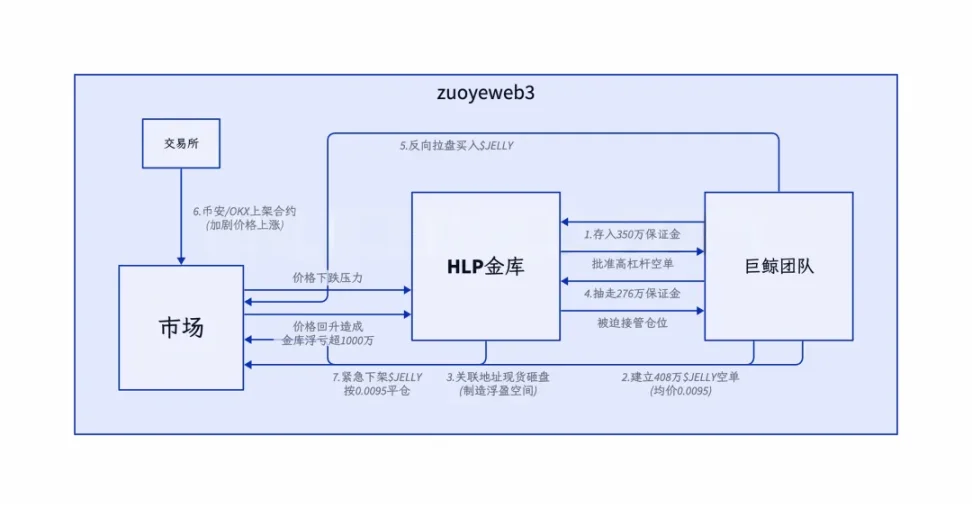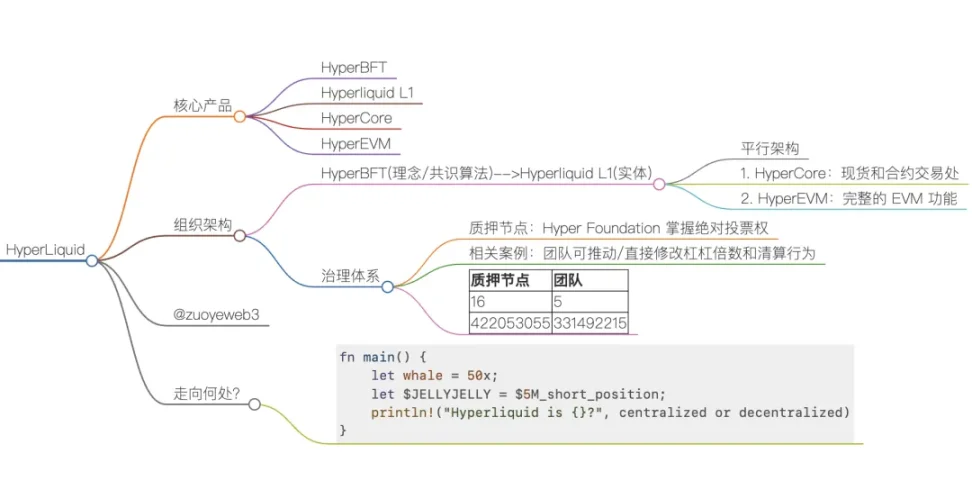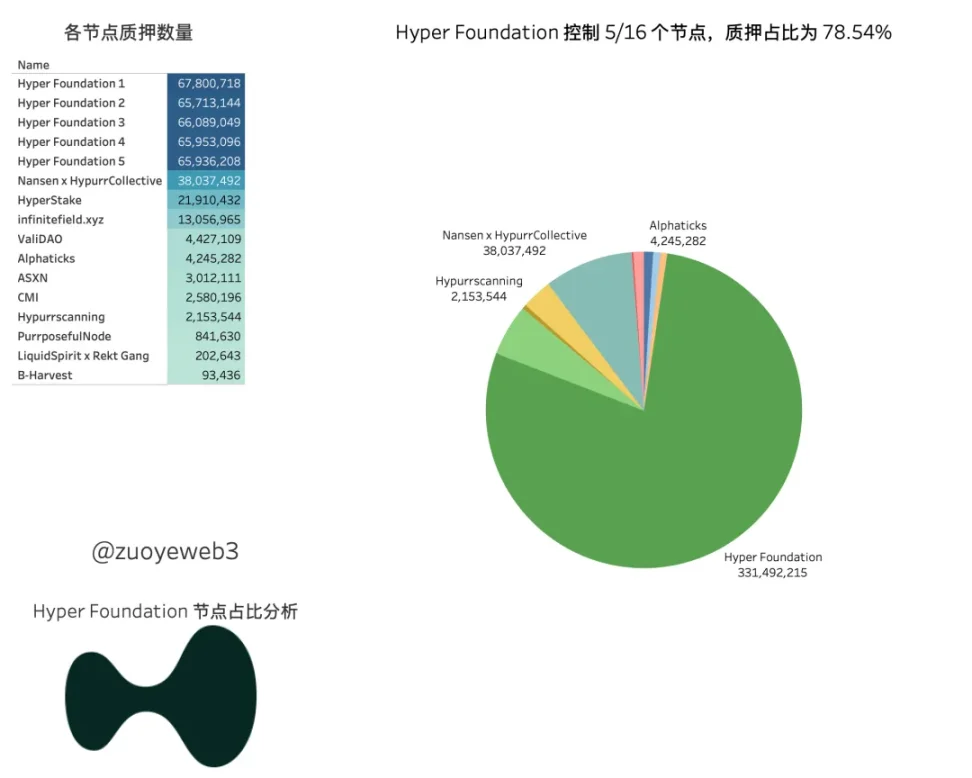Hyperliquid "Ingredient Table": 9% Binance, 78% Centralization

Reprinted from panewslab
03/31/2025·1MAt first, no one cared about this deal, it was just a farce, a "drag network cable", an extinction of an idea (decentralization), and a disappearance of an L1. Until this disaster is closely related to everyone.
On March 26, Hyperliquid encountered a bloody crime caused by a Meme, which was exactly the same as the previous 50x giant whale's method. The giant whale gathered funds and used the "loophole" of the rules to attack the HLP vault.

Image description: Source of the attack process: @ai_9684xtpa
Originally this was a story between an attacker and Hyperliquid. Hyperliquid actually took the opponent of the giant whale. PVP was transformed into PVH, and the loss of $4 million can only be a disease of scabies for the Hyperliquid protocol.
However, Binance and OKX followed the $JELLYJELLY contract, which was a bit of a sign of killing you while you were sick. The truth was similar. If Hyperliquid could take the loss of giant whale based on its capital volume, then exchanges such as Binance could also continue to bleed Hyperliquid with deeper liquidity until excessive blood loss and enter a death cycle similar to Luna-UST.
In the end, Hyperliquid chose to violate the concept of decentralization and chose to remove $JELLYJELLY, commonly known as "drag the network cable", admitting that he can't afford to lose.
To review, Hyperliquid's response is the norm for CEX, and we can also make a judgment. After Hyperliquid, the on-chain ecosystem will gradually recognize this "new normal". Whether centralization is not important, and transparency of governance is more critical.
DEX does not need to be completely decentralized, but will be more transparent than CEX, reaching a certain degree of equilibrium between crypto culture and capital efficiency, and living your life.
9% of Binance: Crypto Culture Surrenders to Capital Efficiency
Pulling the network cable is a dish, plugging the pin is a bad thing, and being caught in market making is stupid.
According to The Block, Hyperliquid has accounted for about 9% of Binance's contract trading volume for two consecutive months. This is the fundamental reason for Binance's fierce response. It has nipped the danger at the starting line, and Hyperliquid has already stepped out of the cradle.
The mall is like a battlefield. Yesterday, Binance was able to grab the wallet market share when OKX DEX was removed. Today, Binance and OK were able to jointly attack under Hayek's big players, which has shown the trend of the three separatist markets in the contract market.
Looking back at the recent industry hotspots, on-chain protocols are very difficult, and it is difficult to insist on decentralization. Polymarket acknowledged the result of the tampering of the UMA oracle by large players, and the community was not satisfied. Hyperliquid eventually "draged the network cable" under Binance pressure and encountered repeated accusations from Bitget CEO and BitMEX Arthur Hayes.
First of all, they are right. Hyperliquid's choice is not an absolute decentralization concept, but capital efficiency and protocol security are preferred. Personally, Hyperliquid's decentralization level is not as good as Coinbase. After all, the latter is really strictly regulated, and Hyperliquid's true face is No KYC CEX as Perp DEX.
Secondly, we must criticize Hyperliquid in the dual identities of CEX and Perp DEX. All the problems of Hyperliquid have been experienced by CEX, including BitMEX of Arthur Hayes, which accused Hyperliquid of not being decentralized enough. In the 2020 March 12 incident, it may ruin the entire encryption industry if the network cable is not pulled out.
Decentralization and centralization are a classic tram problem. To be decentralized, capital efficiency will inevitably be inferior to centralization. If centralized, it will not be able to attract free flow of capital.

Image description: Hyperliquid Organizational Structure Image Source: @zuoyeweb3
Hyperliquid is actually a consensus, two business points:
- The consensus is HyperBFT algorithm and its materialized product Hyperliquid L1;
- The businesses are HyperCore built on L1, which is a customized spot and contract exchange, which is basically controlled by Hyperliquid. In parallel, HyperEVM built on L1 is a "EVM chain" in the usual sense.
In this architecture, the cross-chain behavior of L1 and HyperCore/HyperEVM, and the interaction between HyperCore and HyperEVM are all potential attack points, so the complexity of the organizational structure is also an inevitable move for Hyperliquid project parties to control the disk at a high level.
In the Perp DEX sequence, Hyperliquid's innovation is not in the innovation of architecture, but in a "slightly centralized" way, learning GMX's LP tokenization, and in conjunction with the coin listing and airdrop strategies, it continues to inspire market games and successfully seize the derivatives market firmly occupied by CEX.
It is not about defending hyperliquid, this is the background color of Perp DEX. If you want absolute decentralized governance, you cannot deal with the black swan event. You don’t have time to respond quickly. To respond efficiently, you must be a sword holder.
In fact, just like LooksRare did not defeat OpenSea, Blur finally defeated OpenSea. The centralization of everyone's discussion is also hierarchical. Hyperliquid focuses more on the changes in the protocol. The focus of this article is not to debate the lack of centralization in the final analysis, but to emphasize that capital efficiency will automatically prompt the new generation of on-chain protocols to do this - more centralized in exchange for capital efficiency.
78% Centralization: The Inevitable Measure of Token Economics
The special feature of Hyperliquid is that it exchanges on-chain structure for CEX efficiency, token economics for liquidity, and customized technology stack for security.
In addition to the technical architecture, the real danger of Hyperliquid is the existence of token economics. As mentioned earlier, Hyperliquid is a tokenized upgraded version of GMX LP. Users can share profits in the protocol revenue, thereby creating more liquidity and supporting the token price for the project party.
But the premise is that the project party must have sufficient control capabilities to maintain the normal operation of the agreement revenue, especially in the contract market supported by leverage. The revenue is also more dangerous while amplifying, which is also the biggest difference from spot DEXs such as Uniswap.
The above is the economic principle behind Hyperliquid's choice of a more centralized architecture. Currently, among the 16 nodes, Hyper Foundation controls 5, but in terms of staking, Foundation accounts for 330 million Hypers, accounting for 78.54% of all nodes, far exceeding 2/3 of the majority.

Image description: Hyperliquid node Image source: @zuoyeweb3
Looking back on the security incidents in the past six months:
November 2024 Big V accused Hyperliquid of not centralized architecture: it is basically true
Early 2025: 50x Giant Whale: Makes a mistake that every exchange will make, but the transparency on the chain has become the target of public criticism.
March 26, 2025: "Drag the network cable" to clear JELLYJELLY, which is completely true. The foundation controls the vast majority of voting rights
It is in the repeated games and confrontations that the decentralization concept has gradually bowed to the reality of capital efficiency. Hyperliquid has tried its best to reduce the evil deeds of VC, Airdrop, and internal liquidation (comparing the continuous sale of XRP founders), and has tried its best to retain the normal product form, and hope to make money by handling fees.
Compared with the NFT market being falsified, Perp DEX is a necessity on the chain, so I think hyperliquid's set will inevitably be accepted by the market.
However, just as Bybit was stolen, the community doubted whether the exchange would make money. After Hyperliquid encountered a crisis, it is more worth paying attention to whether the mentality of the founder and team will change. Should we insist on being snatched and pointed at by good people, or to join the exchange in conspiracy and further close the rules.
In other words, whether the focus of the discussion is deviated from the focus of the discussion, or you can think about whether the fully transparent protocol rules lead to the public hunting of the entire market will be a must-have pain for on-chain protocols, or will it lead to the process of on-chain migration backwards.
The real profound lesson or experience is: Should we follow the concept of decentralization or directly surrender to capital efficiency, just like this increasingly swaying world, the middle ground is already narrow.
Should we need partial centralization + transparent rules + intervention if necessary, or should we need 100% centralization + black box status + intervention at all times?
Conclusion
08 After the financial crisis, the US government directly rescued the market, saving Wall Street without the consent of the taxpayer, exhausting the blood of leeks, continuing the veins of flower streets, and becoming the mother of the birth of Bitcoin. Now, Hyperliquid is just a replica of the old drama, but the role has become the on-chain Wall Street to be saved.
After the Hyperliquid crisis, the big Vs took turns torture: from Arthur Hayes to AC, Hyperliquid must adhere to the concept of decentralization, which is also a continuation of the on-chain business war. AC once accused Ethena of the feasibility, and it did not prevent the two from standing on the same front today.
Once a chess player enters the game, he must be prepared to become a chess piece.
Whether on and off the chain, there must be absolute concepts and relative bottom lines.

